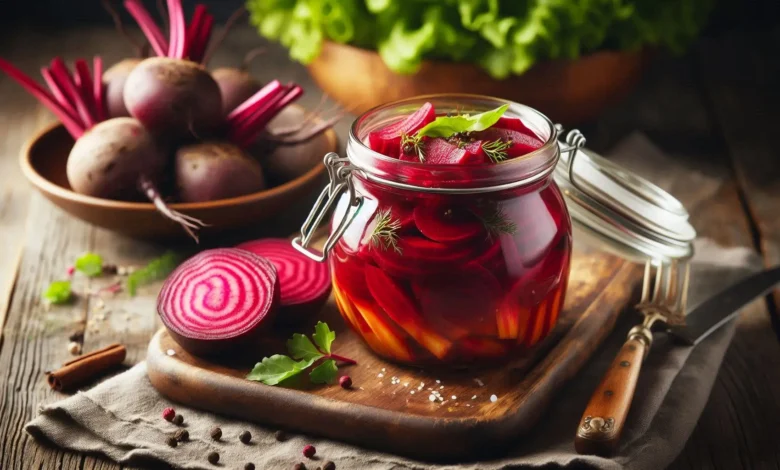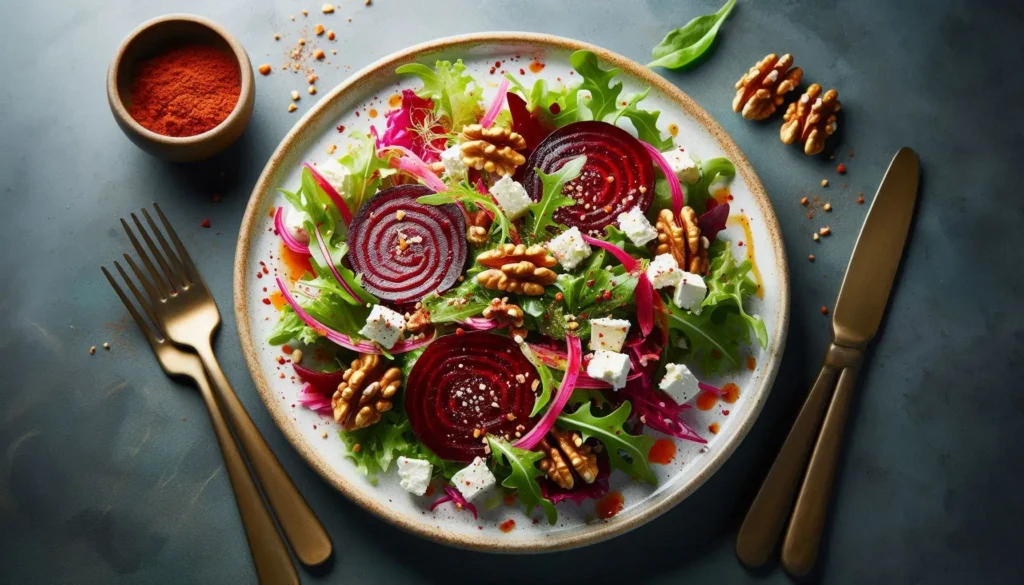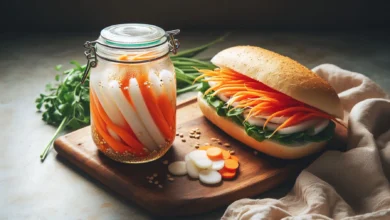Spiced Pickled Beets: A Flavorful Twist on a Classic Preserve
Elevate Your Meals with This Flavorful and Easy Spiced Pickled Beets Recipe

Introduction
Spiced pickled beets are a vibrant and tangy addition to any meal, transforming the humble beetroot into a flavorful delight. This classic preserve not only adds a pop of color to your plate but also brings a unique blend of spices that elevate its taste. Whether enjoyed as a side dish, tossed into salads, or served atop sandwiches, these pickled beets are versatile and easy to make at home.
Pickling beets is a time-honored tradition that dates back centuries, allowing people to enjoy the earthy sweetness of beets long after the harvest season. The process of pickling not only enhances the flavor but also preserves the beets, making them a staple in many kitchens. In this recipe, we’ll explore how to create your own spiced pickled beets, perfect for adding a zesty kick to your meals or gifting to friends and family.
Ready to dive into the world of pickling? Let’s gather our ingredients and get started!
Ingredients
| Ingredient | Quantity | Use filtered water for the best taste. |
|---|---|---|
| 🥕 Beets (medium-sized) | 4 (about 1.5 pounds) | Fresh beets are best for flavor. |
| 🍶 White vinegar (5% acidity) | 1 cup | Can substitute with apple cider vinegar. |
| 💧 Water | 1 cup | Adjust for the desired heat level. |
| 🍬 Granulated sugar | 1/2 cup | Adjust sweetness to taste. |
| 🧂 Salt | 1 teaspoon | Use kosher or sea salt. |
| 🌰 Whole cloves | 1 teaspoon | Adds warmth to the flavor. |
| 🌱 Mustard seeds | 1 teaspoon | Optional for added spice. |
| 🌶️ Black peppercorns | 1 teaspoon | Freshly cracked is preferred. |
| 🥄 Cinnamon stick (2-3 inches) | 1 | Can use ground cinnamon as a substitute. |
| 🍃 Bay leaf | 1 | Remove before serving. |
| 🌶️ Crushed red pepper flakes (optional) | 1/2 teaspoon | Adjust for desired heat level. |
| 🌿 Fresh dill or parsley (optional) | For garnish | Adds freshness to the dish. |
Equipment Needed
| Equipment | Purpose | Notes |
|---|---|---|
| 🥫 Canning jars | For storing pickled beets | Use sterilized jars for safety. |
| 🔪 Sharp knife | For cutting beets | A mandoline can also be used. |
| 🥄 Measuring cups | For measuring ingredients | Ensure accuracy for best results. |
| 🍳 Large pot | For boiling beets | Should be large enough to hold all ingredients. |
| 🔥 Stove | For cooking | Required for boiling and simmering. |
| 🥄 Ladle | For transferring beets to jars | Helps avoid spills. |
| 🌡️ Food thermometer | For checking temperature | Ensures proper cooking. |
| 🧤 Oven mitts | For handling hot jars | Protects hands from burns. |
Preparation Steps for Spiced Pickled Beets
1. Gather Ingredients and Equipment
Ensure you have all the necessary ingredients and equipment ready before you start.
2. Wash and Trim the Beets
- Wash: Rinse the beets under cold running water to remove any dirt. Use a vegetable brush if needed.
- Trim: Cut off the tops and tails of the beets, leaving about an inch of the stem to prevent bleeding during cooking.
3. Boil the Beets
- Place the beets in a large pot and cover them with water.
- Bring the water to a boil, then reduce to a simmer.
- Cook the beets for about 30-45 minutes, or until they are tender when pierced with a fork.
4. Cool and Peel the Beets
- Cool: Once cooked, remove the beets from the pot and place them in a bowl of ice water to stop the cooking process.
- Peel: After cooling, the skins should slip off easily. Use your hands or a paper towel to rub the skins off. If you prefer, you can also use a vegetable peeler.
5. Slice the Beets
- Once peeled, slice the beets into your desired shape (e.g., rounds, wedges, or cubes).
- Aim for uniform thickness to ensure even pickling.
6. Prepare the Pickling Solution
- In a separate pot, combine vinegar, water, sugar, and spices (such as cloves, cinnamon, and allspice).
- Bring the mixture to a boil, stirring until the sugar dissolves.
7. Pack the Jars
- Place the sliced beets into sterilized canning jars, leaving about 1/2 inch of headspace.
- Pour the hot pickling solution over the beets, ensuring they are fully submerged.
8. Seal the Jars
- Wipe the rims of the jars with a clean cloth to remove any residue.
- Place sterilized lids on the jars and screw on the metal bands until they are fingertip-tight.
9. Process the Jars (Optional)
- If you plan to store the pickled beets for an extended period, process the jars in a boiling water bath for 10-15 minutes.
- Allow the jars to cool completely before storing them in a cool, dark place.
10. Let Them Sit
For the best flavor, let the pickled beets sit for at least 24 hours before consuming. They will continue to develop flavor over time.
Tips for Peeling, Cooking, and Slicing Beets
- Peeling: Wearing gloves can help prevent your hands from staining. If you prefer, you can also peel the beets before cooking, but this may result in some loss of color and flavor.
- Cooking: Beets can also be roasted for a deeper flavor. Wrap them in foil and roast at 400°F (200°C) for about 45-60 minutes.
- Slicing: Use a mandoline for even slices, or a sharp knife for more control. Ensure your slices are uniform for consistent pickling.
Pickling Process
1. Prepare the Brine
The brine is essential for flavoring the beets and preserving them. Here’s how to prepare it:
- Ingredients for the Brine:
- 2 cups of vinegar (white or apple cider vinegar)
- 1 cup of water
- 1 cup of granulated sugar
- 1 tablespoon of salt
- Spices (see below)
- Spices Used:
- Whole Cloves: Adds a warm, aromatic flavor.
- Cinnamon Sticks: Provides a sweet and slightly spicy note.
- Allspice Berries: Contributes a complex flavor reminiscent of cloves, cinnamon, and nutmeg.
- Black Peppercorns: Adds a mild heat and depth.
- Bay Leaves: Enhances the overall flavor profile with a subtle herbal note.
- Brine Preparation:
- In a medium saucepan, combine the vinegar, water, sugar, and salt.
- Add the spices (whole cloves, cinnamon sticks, allspice berries, black peppercorns, and bay leaves) to the mixture.
- Bring the mixture to a boil over medium heat, stirring until the sugar and salt dissolve completely.
- Once boiling, reduce the heat and let the brine simmer for about 5 minutes to allow the flavors to meld.
- Remove from heat and let it cool slightly before using.
2. Packing the Beets into Jars
Once the brine is prepared, it’s time to pack the beets into sterilized jars.
- Sterilizing Jars:
Before packing, ensure your canning jars are sterilized. You can do this by placing them in a boiling water bath for 10 minutes or running them through a dishwasher cycle on the hottest setting. - Packing Process:
- Using tongs or a slotted spoon, carefully place the sliced beets into the sterilized jars. Pack them tightly but avoid crushing them.
- Leave about 1/2 inch of headspace at the top of each jar to allow for expansion during processing.
- Once the jars are filled with beets, carefully pour the hot brine over the beets, ensuring they are fully submerged. Use a funnel if necessary to avoid spills.
- If any air bubbles form, gently tap the jars on the counter or use a clean utensil to release them.
3. Sealing the Jars
- Wipe the rims of the jars with a clean cloth to remove any residue that could prevent a proper seal.
- Place sterilized lids on the jars and screw on the metal bands until they are fingertip-tight.
4. Processing the Jars (Optional)
- If you plan to store the pickled beets for an extended period, process the jars in a boiling water bath:
- Place the jars in a large pot filled with boiling water, ensuring they are covered by at least an inch of water.
- Boil for 10-15 minutes, depending on your altitude and jar size.
- Remove the jars and let them cool completely on a clean towel or cooling rack.
5. Storing the Pickled Beets
- Once cooled, check the seals by pressing down in the center of each lid. If it doesn’t pop back, the jar is sealed properly.
- Store the sealed jars in a cool, dark place. For the best flavor, let the pickled beets sit for at least 24 hours before consuming.
Storage Instructions for Spiced Pickled Beets
1. Storing the Pickled Beets
- Refrigeration:
If you have processed the jars using a boiling water bath, they can be stored in a cool, dark place, such as a pantry or cupboard. Once opened, however, the jars should be refrigerated. - Shelf Life:
- Unopened jars of pickled beets can last for up to 1 year when stored in a cool, dark place.
- Once opened, store the jar in the refrigerator, where the pickled beets will remain good for about 1-2 months. Always check for signs of spoilage, such as off smells or mold, before consuming.
2. Tips for Serving and Using Pickled Beets
- Serving Suggestions:
- Serve pickled beets as a tangy side dish or salad topping. They pair well with goat cheese, feta, or blue cheese.
- Add them to charcuterie boards for a pop of color and flavor.
- Use them as a garnish for sandwiches, burgers, or wraps to add a zesty crunch.
- Incorporating into Dishes:
- Toss pickled beets into salads for a vibrant addition. They work well in mixed greens, grain salads, or even as a topping for grain bowls.
- Blend pickled beets into hummus for a colorful and flavorful dip.
- Use them in tacos or grain bowls for a unique twist.
- Creative Uses:
- Chop pickled beets and mix them into coleslaw for added flavor and color.
- Incorporate them into pasta dishes or grain salads for a sweet and tangy element.
- Use the pickling liquid as a dressing for salads or as a marinade for vegetables.
3. Additional Tips
- Flavor Development:
The flavors of pickled beets improve over time, so allowing them to sit for at least 24 hours before consuming is recommended. For the best taste, enjoy them after a week of marinating. - Experiment with Recipes:
Feel free to experiment with different spices and flavorings in your pickling brine to create unique variations of pickled beets that suit your taste preferences.
Serving Suggestions for Spiced Pickled Beets
1. In Salads
- Mixed Green Salad: Toss pickled beets with mixed greens, goat cheese, walnuts, and a light vinaigrette for a refreshing salad.
- Grain Salad: Combine pickled beets with quinoa or farro, diced cucumbers, feta cheese, and a lemon-olive oil dressing for a hearty grain salad.
- Coleslaw: Add chopped pickled beets to traditional coleslaw for a colorful twist and a tangy flavor.
2. In Sandwiches and Wraps
- Vegetarian Sandwich: Layer pickled beets on whole-grain bread with hummus, avocado, and fresh spinach for a nutritious and flavorful sandwich.
- Burgers: Use pickled beets as a topping for burgers, whether beef, turkey, or veggie, to add a sweet and tangy crunch.
- Wraps: Include pickled beets in wraps with roasted vegetables, greens, and a spread like tzatziki or cream cheese.
3. As a Side Dish
- Charcuterie Board: Serve pickled beets alongside cured meats, cheeses, olives, and crackers for a vibrant charcuterie board.
- Grilled Meats: Pair pickled beets with grilled chicken, pork, or fish for a refreshing contrast to the savory flavors.
- Tacos: Use pickled beets as a topping for tacos, adding a burst of flavor and color to your favorite fillings.
4. Creative Uses
- Pasta Dishes: Toss pickled beets into pasta salads or serve them alongside warm pasta dishes for a pop of color and acidity.
- Pizza Topping: Add pickled beets to flatbreads or pizzas for a unique flavor combination, especially with goat cheese or arugula.
- Dips: Blend pickled beets into hummus or yogurt-based dips for a colorful and flavorful appetizer.
5. Pairings with Other Foods and Beverages
- Cheese Pairings: Pickled beets pair well with creamy cheeses like goat cheese, ricotta, or blue cheese. Serve them with a cheese platter for a delightful contrast.
- Wine Pairings: Enjoy pickled beets with a light white wine, such as Sauvignon Blanc or a fruity rosé, which complements their tangy flavor.
- Beer Pairings: Pair with a light lager or a fruity wheat beer to balance the acidity of the beets.
6. Garnishing and Presentation
- Garnish: Use pickled beets as a garnish for soups, such as borscht or creamy soups, to add color and flavor.
- Presentation: Serve pickled beets in small bowls or on platters to showcase their vibrant color, making them an attractive addition to any meal.

| Nutrient | Amount per 100g | Health Benefits |
|---|---|---|
| Calories | 43 kcal | Low in calories, making them a great addition to a weight management plan. |
| Carbohydrates | 9.6 g | Provides energy; and contains natural sugars for a quick energy boost. |
| Dietary Fiber | 2.2 g | Supports digestive health and helps maintain a healthy weight. |
| Protein | 1.6 g | Contributes to muscle repair and growth. |
| Fat | 0.2 g | Very low in fat, making them heart-healthy. |
| Vitamin C | 4 mg (7% DV) | Antioxidant that supports the immune system and skin health. |
| Folate | 109 µg (27% DV) | Essential for DNA synthesis and important during pregnancy for fetal development. |
| Potassium | 325 mg (7% DV) | Helps regulate blood pressure and supports heart health. |
| Magnesium | 23 mg (6% DV) | Important for muscle and nerve function, as well as bone health. |
| Antioxidants | N/A | Contains betalains, which have anti-inflammatory and antioxidant properties. |
Health Considerations
- Oxalates: Beets contain oxalates, which can contribute to kidney stone formation in susceptible individuals. Moderation is advised for those with a history of kidney stones.
- Blood Pressure: The high nitrate content in beets may help lower blood pressure, but individuals on blood pressure medications should consult their healthcare provider.
- Sugar Content: While beets are naturally sweet, they do contain sugars. Those monitoring their sugar intake should consider portion sizes.
Conclusion
In summary, this recipe for spiced pickled beets is not only simple to make but also adds a burst of flavor and vibrant color to any dish. Whether you enjoy them on a charcuterie board, as a topping for salads, or as a unique side dish, these pickled beets are sure to impress. We encourage you to try making this recipe at home and experiment with your own variations! Don’t forget to share your experiences or any creative twists you come up with in the comments below—we’d love to hear from you!
If you enjoyed this recipe and want to discover more delicious ideas, consider subscribing to our magazine for the latest culinary inspiration. Follow us on social media for daily updates, tips, and mouthwatering recipes. Check out our Pickling Recipes section.





